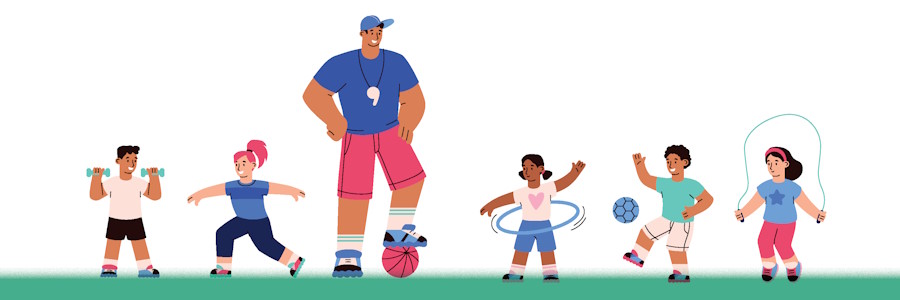Coaching Kids with ADHD in Sports
Attention Magazine February 2024
“Jimmy, please stop digging in the dirt,” said the coach. “Get in the ready position, and be prepared if the ball gets hit to you.”
Does this sound familiar?
For many kids with ADHD, staying focused during periods of inactivity or when they don’t have the ball can be challenging. This affects their performance and ability to work together with a team, which can lower their self-esteem. If they frequently make mistakes and miss plays, over time their teammates will feel that they cannot rely on them as a player. As a result, the child may lose interest in continuing to play on a sports team even if they love the sport.

Do you coach youth sports? Are you the parent of a child with ADHD who struggles to stay focused while playing sports? Coaches can draw on various strategies and tools to help keep kids with ADHD better focused and engaged while playing sports. Parents can support their child’s understanding of the game and learn how to communicate with the coach effectively. Whether you’re a parent, a coach, or both, here’s how you can help these kids face their ADHD-related challenges during sport activities.
Participating in youth sports provides numerous benefits for kids with ADHD that extend beyond the sport itself. By implementing these strategies and fostering open communication, coaches and parents can help children with ADHD thrive and enjoy the many positive experiences offered by sports.
Strategies for coaches
The following strategies are some of the ways coaches can help kids with ADHD stay engaged and focused during practices and games.
ASSIGN CONCRETE TASKS
Give kids a specific task to keep them engaged when they don’t have an active role during a game. For example, with a baseball player in the outfield, ask the player to help you count the number of pitches. Check back periodically to ask what pitch number they are on. This can keep the child focused on the batter, so he/she is better engaged and can then be ready if the ball is hit to them. For basketball, ask a player on the bench to count how many times the other team passes the ball once they cross the midcourt line until someone shoots for the first time. From the sideline, players could track stats in writing to further engage them in watching the game.
ENCOURAGE CONTROLLED MOVEMENT
Encourage kids to engage in slight movements that help them stay ready and focused instead of the natural fidgeting that will occur when left to their own devices. For example, you could have them move their legs quickly up and down, snap their fingers, or do something similar.
USE VISUAL OR AUDITORY CUES
Utilize visual or auditory cues to help kids remember important instructions or actions during the game. For instance, with baseball, have a first base coach hold a glove out beyond the base and have each player give the coach a high five after they run through first base. This helps train players to remember not to stop at first and run through the base. A coach could also create hand signals or verbal code words that can be used to discreetly redirect a player who is not doing what they are supposed to be doing. This can get their attention and reduce negative feelings about constantly being asked to adjust their actions.
BREAK DOWN THE GAME
Break down the game into small segments and practice each part separately, gradually integrating them into gameplay. For instance, to help players learn to pass the ball down the court in basketball, have kids first do this by passing to players standing next to cones in particular places on the court without defense. Then, maybe have them pass wherever they want, but they have to do it three times with no defenders. After that, add in defenders. Help them maintain the consistency of passing even with defenders.
KEEP KIDS OCCUPIED DURING DOWNTIME
Assign relevant tasks to keep kids occupied during transition times to prevent distractions. For example, have the player help to set up cones for the next drill. Or perhaps have them help demonstrate the next activity, which would also help ensure that they are paying attention and know what to do when it is time to do it themselves.
GIVE TACTFUL FEEDBACK
Be mindful of providing feedback in a tactful manner, incorporating positives along with areas for improvement. For example, you could say something such as “Great job watching for the ball, but make sure you are holding your glove up higher so you can more easily grab a pop fly.” Also, if a child follows your guidance make sure to praise them because that can help reinforce their continuing those positive actions.
Strategies for parents
Parents play a crucial role in supporting their child with ADHD in sports. Here are some strategies they can use.
PROVIDE GLOBAL OVERVIEW
Use action figures or visual aids to help kids understand the bigger picture of how the sport works and how different positions fit together. For example, at home, or even on a basketball court, set up the five players as action figures or even chess pieces as well as a hoop. Move the players around the “court,” illustrating what each position/player should be doing.
WATCH AND DISCUSS
Watch the sport together on television or attend live games to help your child see the sport in action and facilitate a better understanding of the game and how each player position works together.
UTILIZE VIDEO GAMES
Some kids may find playing the sport in a video game format helpful in better understanding the game dynamics.
PRACTICE AT HOME
Offer to play the sport with your child or help them practice. It’s important not to push too much or force them to practice if they really don’t want to. However, giving them structure to make the choice to play or practice can be helpful, especially initially.
SELF-PACED PRACTICE TOOLS
If a child has trouble getting themselves to practice, they may need more structure. Perhaps you can help them to make a practice plan for themselves. Alternatively, apps or programs such as Dribble Up, which provide online platforms that are interactive and help kids learn and practice skills for specific sports in a fun way, could be helpful.
COMMUNICATION WITH COACHES
Parents should consider communicating with their child’s coach about their ADHD and any specific challenges. As a parent, you have the ability to choose what to share or not share with your child’s coach. While some coaches may pick up on ADHD anyway and know what to do, others likely will not. Communication with your child’s coach is important, especially for younger kids. Decide whether you feel comfortable sharing with the coach that your child has ADHD. Alternatively, you could potentially explain that your child has some challenges with attention and executive function skills without giving the diagnosis by name. By opening up lines of communication, you give the coach more information to work with, which can also help them to be more understanding and less likely to attribute a lack of focus to limited interest in participating.


 Carey A. Heller, PsyD, is a licensed psychologist based in Maryland. He specializes in the evaluation and treatment of ADHD and executive function issues. Learn more at
Carey A. Heller, PsyD, is a licensed psychologist based in Maryland. He specializes in the evaluation and treatment of ADHD and executive function issues. Learn more at 